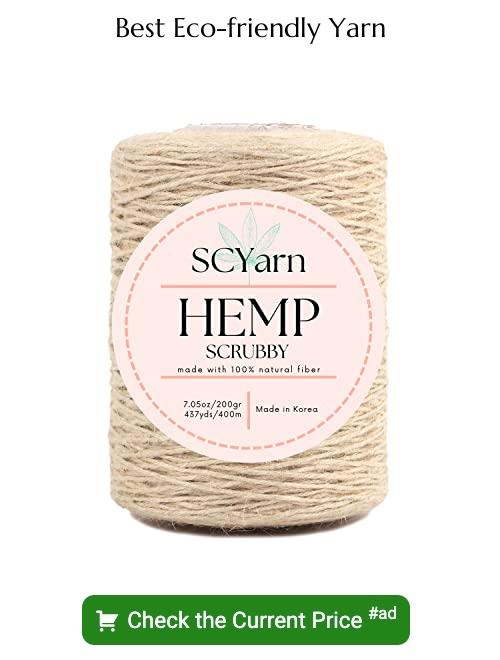Explore the endless possibilities of green yarn in crafting because its vibrant hue can bring any project to life.
Green yarn, a versatile staple in crocheting and knitting, can indeed imbue your projects with a vibrant touch of nature. This article delves into the world of green yarn, exploring its types and uses, and suggesting the best brands to consider.
You’ll discover how the color green can bring out unique aesthetics in your yarn crafts, influencing the mood and feel of the finished items, from an elegant emerald knitted scarf to a soft, sage crocheted blanket.
Additionally, stay tuned to reveal tips on matching green yarn with other colors in your projects. This comprehensive guide is here to navigate your green yarn journey and empower you to make informed decisions that could propel your crocheting and knitting endeavors to new creative heights.
Key takeaways:
- Green yarn comes in a variety of shades and materials.
- Consider the environmental impact of green yarn and choose sustainably produced options.
- When buying green yarn, consider the project, color psychology, fiber content, dye method, and care instructions.
- Popular brands offering green yarn include Lion Brand, Red Heart, Drops Designs, Malabrigo, Berroco, and Cascade Yarns.
- Use green yarn for highlighting details, color-blocking, gradient projects, contrast, accents, seasonal projects, and more.
Different Types of Green Yarn
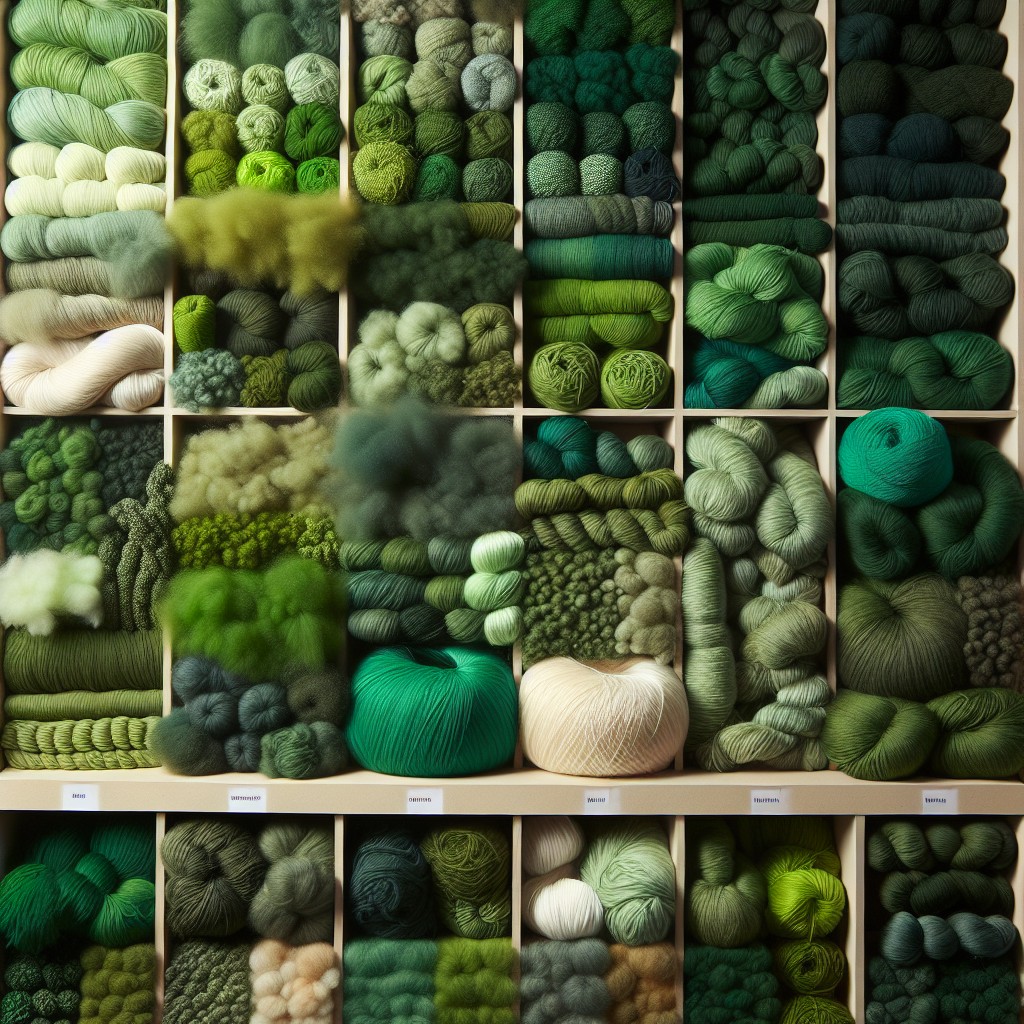
Among the myriad shades of green, you will find forest greens deep and rich as a coniferous canopy. Mint greens are delicately refreshing, perfect for a spring project. Olive greens carry an earthy aesthetic that radiates warmth and comfort. Neon greens, while not for the faint-hearted, can add a vibrant pop of color and fun to your creations.
In terms of material, common types include wool, cotton, silk, acrylic and blends. Wool, like Merino or Shetland, is a classic choice known for its warmth and durability. It’s excellent for winter projects. Cotton, lighter and more breathable, suits summer crafts. Silk yarn provides luxurious softness and a distinctive sheen, ideal for sophisticated pieces. Acrylic, though synthetic, is highly versatile, budget-friendly, and easy to maintain, making it a staple in many crafters’ supplies.
It’s important to keep in mind that each type offers a unique texture and stitch definition, affecting the final look and feel of your project. The right green yarn is there; you just need to identify the perfect shade and material for your specific crafting needs.
Environmental Impact of Green Yarn

Yarn production inevitably has a footprint on the environment. Fortunately, many companies have taken steps to mitigate this. Some brands offer environmentally-friendly variants using organic or recycled materials, which reduce their carbon emissions. These green yarns often utilize natural dyes, saving water and avoiding harmful chemicals.
In addition, a number of manufacturers have started eco-conscious operations like optimizing energy consumption, minimizing waste, and supporting fair trade. Consumers, too, can contribute by preferring yarns labeled as sustainably produced. Easily biodegradable fibers like cotton, linen, or wool are other good options for a lesser environmental impact.
However, it’s also essential to mention that while these measures help, they are not a complete solution. As artisan crafters, careful consideration of our material choices contributes to the overall health of our shared planet. Choosing yarn wisely and reusing or recycling leftover materials responsibly are crucial steps in the right direction.
Considerations When Buying Green Yarn
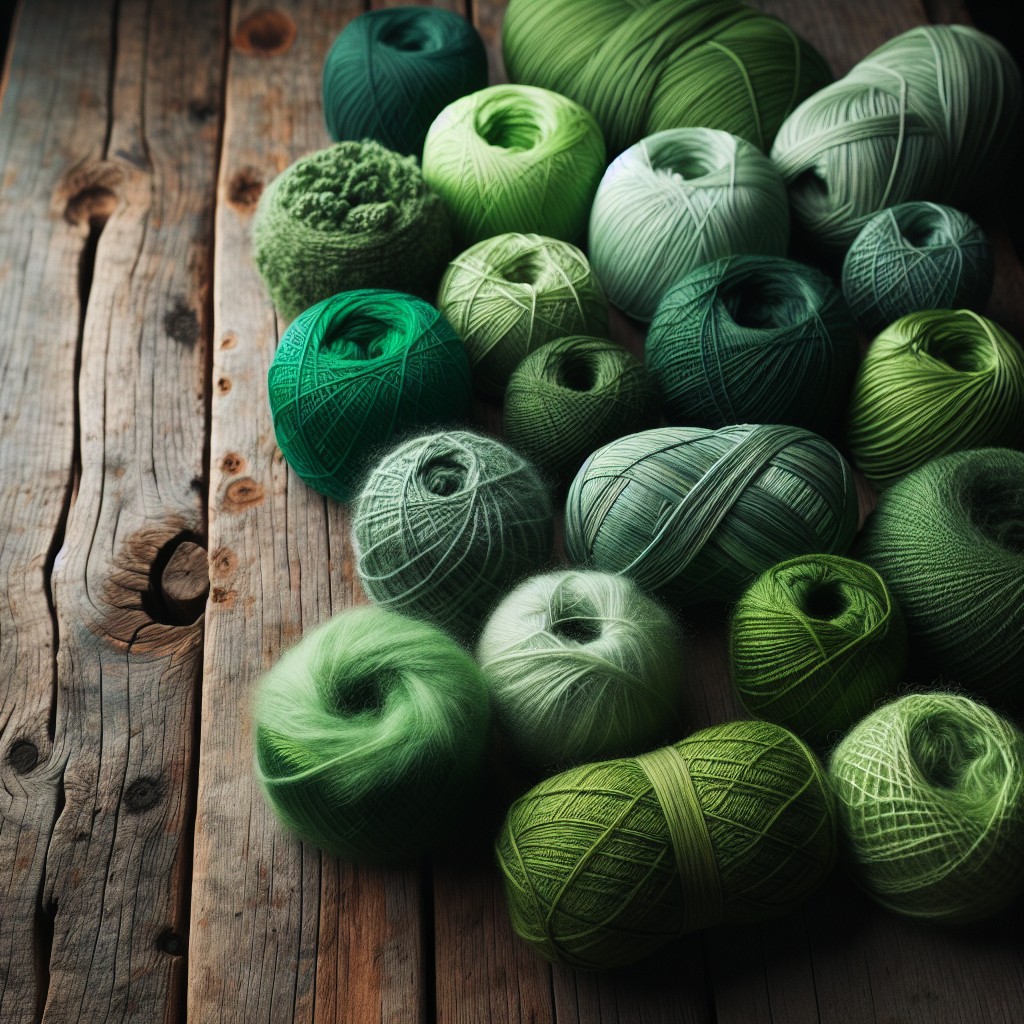
When selecting your green yarn, keep the project end-use in mind. Socks, for example, require durable, machine-washable fibers such as nylon or superwash wool. An heirloom-quality shawl, on the other hand, might demand the luxury and warmth of alpaca or cashmere.
The shade of green also matters – olive, mint, forest, lime – each could drastically alter the look of your finished piece. You might wish to consider the color psychology of green, often associated with peace, tranquility, and health, as this can subtly influence the perception of your crafted item.
Take note of the dye method as well. Hand-dyed yarn can produce stunning non-repeating colorways, while commercially dyed yarn generally provides consistency across dye lots.
Fiber content and weight of the yarn will play a role as well. If the temperature is a concern or if you’re working towards a drapey finish, lighter weight yarns, such as lace or fingering, make a good choice.
Always remember to check the care instructions. Not all yarns can be machine washed or tumble dried, and this could be a deciding factor depending on how you or the recipient plan to care for the completed project.
Lastly, be conscious of the environmental impact of your choice. Look for organic, sustainably sourced yarns wherever possible, keeping in mind that natural dyes are kinder to our planet than synthetic ones.
Selecting the right green yarn ultimately hinges on balancing the needs of your project with your aesthetic preferences and ethical considerations. Exploring a few different options can go a long way to ensuring you make an informed decision that you’ll be happy with.
Popular Brands Offering Green Yarn
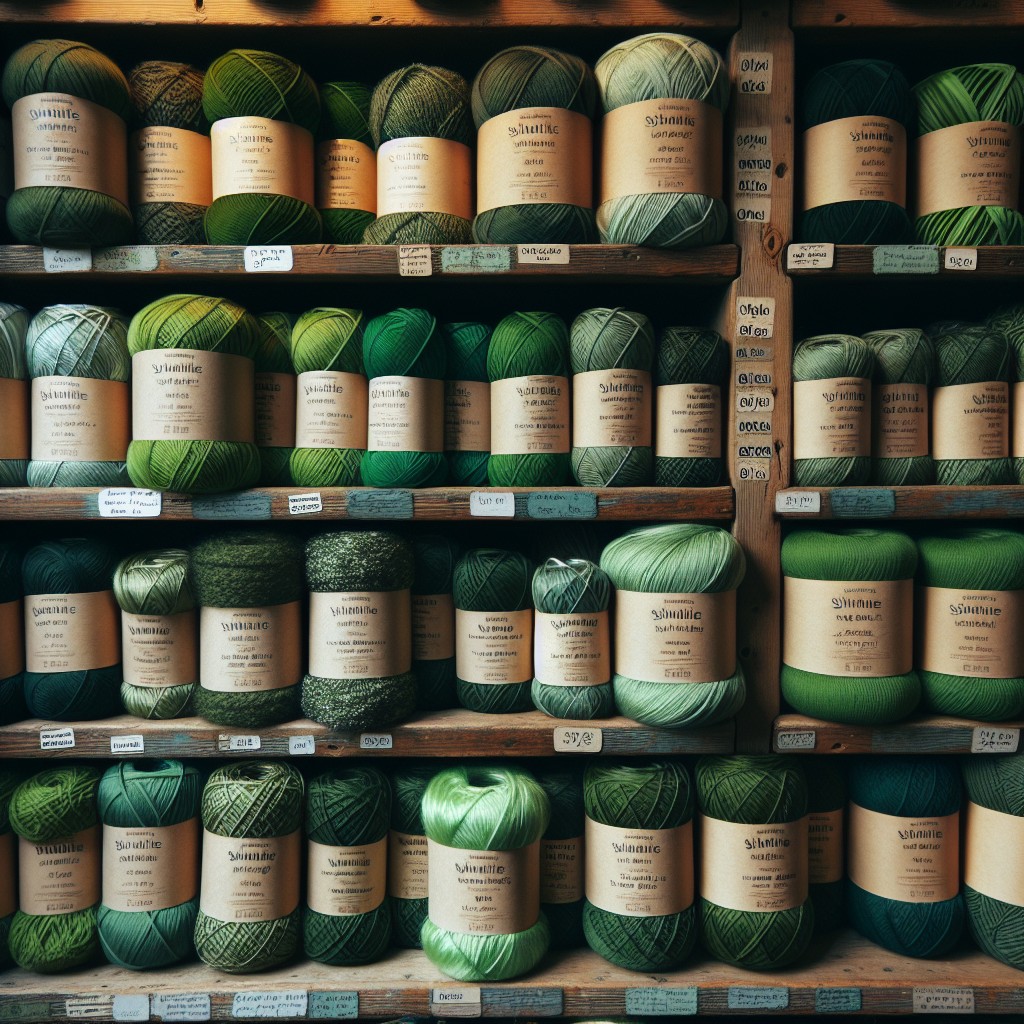
Several manufacturers and distributors cater to the needs of the green yarn enthusiast.
1. Lion Brand Yarn: Known for its wide array of colors, Lion Brand doesn’t disappoint when it comes to green. With varieties from mint to olive, this company gives you a spectrum to choose from.
2. Red Heart Yarn: This brand is well-liked because of their super saver yarn. Their color palette includes various green tones such as lime, spring green, and dark sage.
3. Drops Designs: Committed to creating natural fibers, their color range for green yarn includes jade, army, and pistachio.
4. Malabrigo Yarn: If you desire luxurious hand-dyed green yarns, look no further. From Lettuce to Fresco Y Seco, you can find a wide array of green shades.
5. Berroco: For soft and durable yarn ideal for both knitting and crocheting, Berroco offers different types of green from grass to emerald.
6. Cascade Yarns: Known for their high-quality products, Cascade Yarns provide green yarn in a variety of fibers and shades.
Regardless of the shade or fiber type you’re seeking, these brands have a broad range of green yarns that could just be what your project needs.
Hand-Dyeing Yarn Green At Home
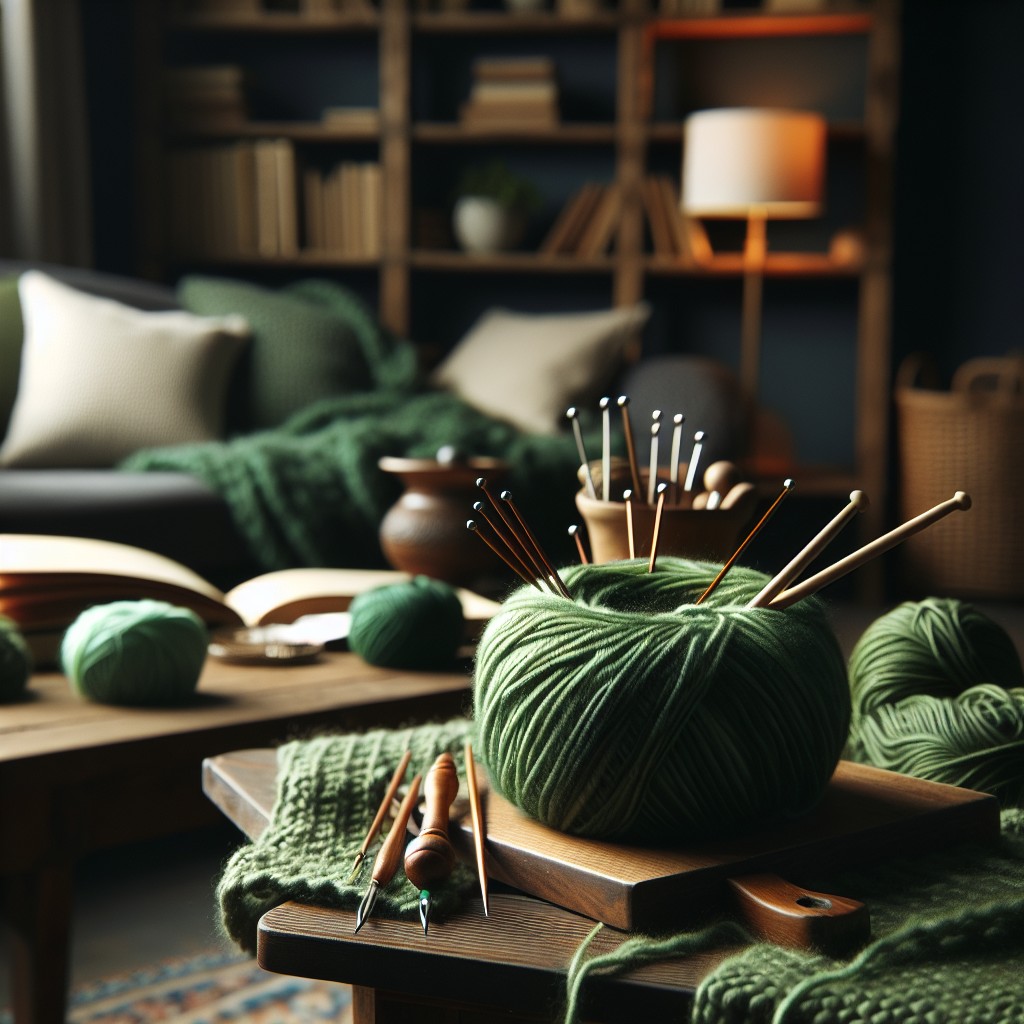
In the exciting world of yarn crafts, taking control of your color palette can be as fulfilling as creating the piece itself. That’s where hand-dyeing comes in. Creating your own shade of green at home allows you to explore a spectrum of shades that can’t always be found in store-bought varieties.
For yarn made of natural fibers, consider using eco-friendly dyes derived from plants. For instance, nettle and spinach can yield a lovely muted green. Synthetic yarns, on the other hand, may require commercial dyes.
The process involves soaking the yarn, preparing the dye bath according to the specific instructions, submerging the yarn and allowing it to soak until the desired hue is achieved. Once done, rinse the yarn thoroughly and allow it to dry completely before use. A tip to bear in mind is to always wet the yarn prior to dyeing as it allows the color to distribute more evenly.
It’s important to note that different fibers react differently to dyes. Wool and silk, for example, typically absorb color well. Cotton can be more challenging but far from impossible with the right dye.
Care Instructions for Green Yarn
To maintain the vibrancy and integrity of your green yarn, it’s essential to abide by specific care instructions.
1. Always read the label: Most yarns come with cleaning and care labels, indicating if they are machine washable or require hand washing.
2. Be gentle with temperature: Heat can cause yarn colors to fade, and harsh detergents can also have a similar effect. Therefore, it’s recommended to wash your green yarn garments in cold or lukewarm water with a mild detergent.
3. Dry carefully: Never wring the garment as it can distort the stitches. Instead, carefully squeeze out excess water and lay flat to dry. Avoid direct sunlight to prevent color fading.
4. Monitor tension when working: Keeping consistent tension throughout your project ensures the finished item will have an even color distribution. Altered tension can create discrepancies in color saturation.
Remember, the longevity of your green yarn pieces significantly depends on how you care for them.
Understanding Yarn Weights and Fiber Types
Knowing the weight of your yarn is crucial as it directly influences the drape and look of your final crochet or knitting project. Green yarn is no exception to this principle.
Yarn weight refers to its thickness. Common categories include thread, lace, light fingering, fingering, sport, DK, worsted, aran, bulky, and super bulky. As you progress from thread to super bulky, the yarn becomes thicker and your project will knit or crochet up faster.
Fiber type also plays a vital role. Natural fibers such as cotton, wool, alpaca, and silk offer different textures and draping characteristics. For instance, cotton is perfect for dishcloths due to its absorbency and durability, while alpaca or wool provides warmth and is ideal for sweaters or blankets.
Synthetic fibers, such as acrylic and polyester, can mimic the qualities of natural fibers while often being more budget-friendly and machine washable. Some green yarns might also be a blend of natural and synthetic fibers, providing a balance between the characteristics of both.
It’s essential to keep in mind that the weight and fiber type can affect the color and sheen of the green yarn. The same dye may look darker on wool than on cotton due to the way different fibers absorb color.
Advantages of Using Green Yarn
Green yarn can tremendously impact your craft projects in several positive ways. Firstly, it provides a natural touch to your creations. Depending on its shade and weight, it can represent everything from new beginnings to growth, making your handmade items resonate with meaning.
Moreover, green yarn is incredibly versatile. There are essentially countless shades available ranging from pale, barely-there hues to deep, rich emeralds, providing a choice for every project and mood.
If you’re aiming for a specific aesthetic, opting for green yarn helps in creating a calming vibe, as it’s often associated with nature and tranquility. It’s also an excellent color choice for Christmas themed projects and those inspired by outdoor landscapes.
Lastly, green yarn pairs wonderfully with a wide array of colors. It complements other earth tones such as browns and tans, but also can create a striking contrast when used with reds or purples. This makes it an asset in any yarn stash.
Working With Green Yarn in Different Knitting and Crocheting Projects
Having a variety of projects in mind is beneficial when opting for green yarn. Here’s how you can efficiently integrate this color into your crafts:
1. Highlighting Details: Use a vivid green tone to emphasize patterns. It brings out intricate design elements, particularly in complex stitches like cables or lace.
2. Color-Blocking: Create bold designs through color-blocking. A striking block of green can draw attention and add a refreshing vibe to your work.
3. Gradient Projects: Different shades of green yarn can make eye-catching gradient projects. Consider light green transitioning into a dark forest tone for a lush, calming effect.
4. Contrast & Harmony: Green yarn pairs well with many colors. You can create contrast with reds and oranges or harmony with blues and purples.
5. Accents in Neutral Projects: For a piece that is largely in grayscale or earth tones, a touch of green can serve as a lively accent.
6. Seasonal Projects: Use green yarn for festive knits. Think springtime florals, summery leaf motifs, or Christmas-themed crafts.
Remember, the right hue of green yarn can entirely change the mood of your project. So, go beyond the usual and experiment with green for unique, stylish, and dynamic pieces.
How to Combine Green Yarn With Other Colors
An understanding of color theory can enhance your crafting projects using green yarn.
Firstly, for a harmonious look, consider using analogous colors. These are colors that sit next to each other on the color wheel. For green, that’s blue and yellow.
Secondly, complimentary colors can add visual interest. This is the color directly opposite on the color wheel. For green, that’s red.
Tertiary colors, those that are mixed from primary and secondary hues, can provide subtle sophistication. The family includes colors like teal and olive, which combine well with green yarn.
Don’t forget about the versatile neutrals like white, black, and shades of gray. These can help green yarn pop or balance, depending on your intent.
Lastly, experiment with different tones, tints, and shades. Even within the green family, light lime green and dark emerald cut very different figures. Play with these varieties to find the perfect combination for your project.
Remember, these are not hard and fast rules. Feel free to experiment and find combinations that appeal to your aesthetic.
Recognizing High-Quality Green Yarn
High-quality yarn boasts several distinguishable characteristics. The first is its fiber content. Natural fibers such as wool, cotton, silk, and cashmere usually yield a more luxurious feel than synthetic fibers. However, blends have their merits too, especially when considering durability and ease of care.
Next, consider the ply of the yarn. High-quality yarn often has multiple plies, improving the integrity of the yarn and making it less prone to fraying or splitting.
The dye quality is another indicator. Higher-end green yarn should retain its vibrancy even after multiple washes, with no bleeding or fading.
Finally, the smoothness and evenness of the yarn can signify its quality. Well-spun yarn will have a consistent thickness throughout, with no slubs or thick and thin sections unless it’s a specialty yarn.
Remember, though these are general guidelines, the ‘best’ yarn highly depends on your project and personal preferences. Don’t be afraid to experiment with different fibers, lengths, weights, and brands to find the perfect fit.
Yarn Storage Tips to Maintain the Color of Green Yarn
Storing your yarn correctly is crucial to maintaining its vibrant green color and overall quality. Consider these suggestions:
1. Keep Yarn Away from Direct Sunlight: Sun can bleach yarn over time, causing it to lose its color intensity. Store your yarn in a cool, shaded location.
2. Use Archival Storage Materials: Use acid-free tissue paper and boxes for yarn storage, as they’ll prevent color fade and degradation.
3. Protect from Moisture: Moisture can lead to mold and color alteration. Ensure your storage area is dry.
4. Guard against Pests: Certain pests are attracted to natural fiber yarns and can damage its color and structure. Store your yarn in a tightly sealed container to deter them.
5. Avoid Ironing: Heat can alter the dye composition, leading to color change. Avoid ironing dyed yarn directly.
Taking these steps can help maintain your green yarn’s color and ensure it looks as vibrant in your finished projects as it did when you first purchased it.
Understanding the Symbolism of Green in Yarn Crafts
In yarn crafts, color plays a significant role beyond aesthetic appeal. Each color bears a symbolic meaning or emotion. Green generally symbolizes growth, renewal, and nature – mimicking the hues of trees, plants, and grass. It’s often associated with tranquility, good luck, health, and jealousy.
Working with green yarn in your projects can symbolize:
- Growth and Renewal: Just like springtime brings about fresh bloom, green in yarn crafts can symbolize new beginnings and progress.
- Nature and Relaxation: The calming hues of green often channel the serenity of nature, making it a great color option for projects meant for relaxation like blankets or shawls.
- Wealth and Good Luck: If you’re crocheting or knitting something as a gift, using green can wish the recipient prosperity and good fortune.
Remember, the symbolism behind the colors you choose for a project can bring an extra layer of intention and passion to your creations.
Impact of Light On the Appearance of Green Yarn
Understanding light’s influence on hues can enhance the quality of your yarn crafts. Light sources vary from direct sunlight to fluorescent, LED, incandescent, or even candlelight. Each type affects how we perceive colors, including green.
In outdoor sunlight, a vibrant emerald shade may enrich the overall aesthetic. Direct sunlight brings out the brightness in green, making it pop.
Indoor lighting tends to soften the appearance of green. Under LED or fluorescent light, green yarn may appear slightly cooler. Warm types like incandescent lights can yield a muted, warm green.
Also, the room color can impact the light reflection on the green yarn. A blue-painted room may cause the yarn to seem more turquoise, while a yellow room can result in a lime shade.
This is why it’s beneficial to see the yarn in various light settings before making your final decision. This ensures the chosen color aligns with your vision or the pattern requirements. It’s an effective way of getting the precise shades intended for your project.
FAQ
What type of yarn is eco friendly?
Eco-friendly yarns include ones made from natural materials such as wool, cotton, silk, bamboo fiber, and banana fiber, as their production involves no synthetic materials, thus causing no environmental harm.
When not to use acrylic yarn?
Acrylic yarn should be avoided when prioritizing environmental sustainability, moisture absorbency, or comfort, as it has harmful environmental effects, inadequate moisture-wicking capabilities, and may present an unpleasant texture during use.
What is renewable yarn?
Renewable yarn is a type of sustainable yarn that is derived from renewable and biodegradable materials like organic cotton, linen, or hemp, minimizing the negative environmental and social impacts.
What is the most expensive yarn you can buy?
The most expensive yarn available for purchase is made from Vicuna fiber.
What makes bamboo yarn a sustainable choice?
Bamboo yarn is considered a sustainable choice as bamboo plants grow rapidly, do not require pesticides or fertilizers, and require less water than many other plants used for fiber.
How does the process of creating recycled yarn work?
The process of creating recycled yarn involves salvaging, cleaning, detangling, and re-spinning fibers from old, discarded textiles.
Which yarn materials are best for those with sensitive skin?
Bamboo, organic cotton, and silk are ideal yarn materials for individuals with sensitive skin due to their natural softness and hypoallergenic properties.
